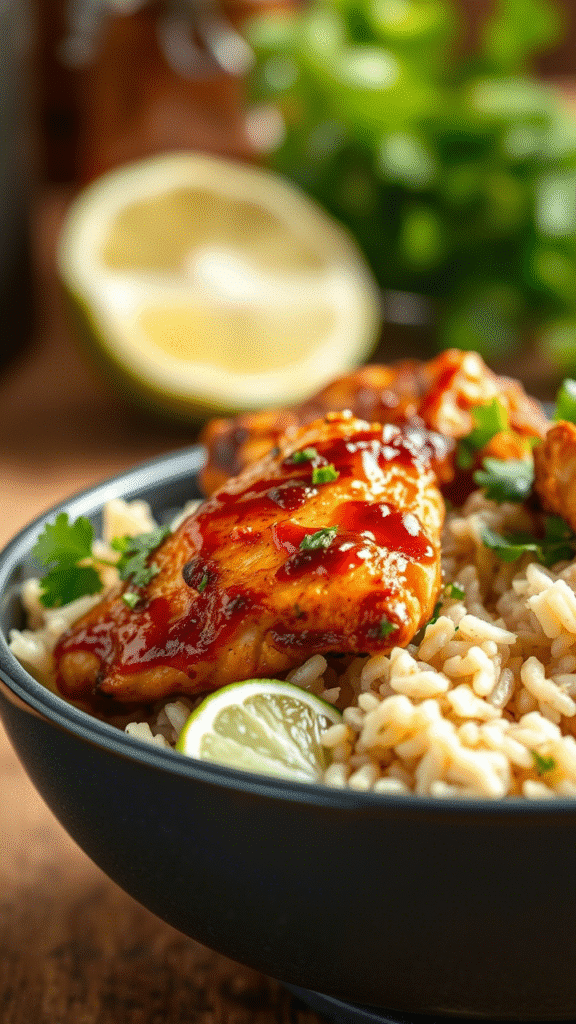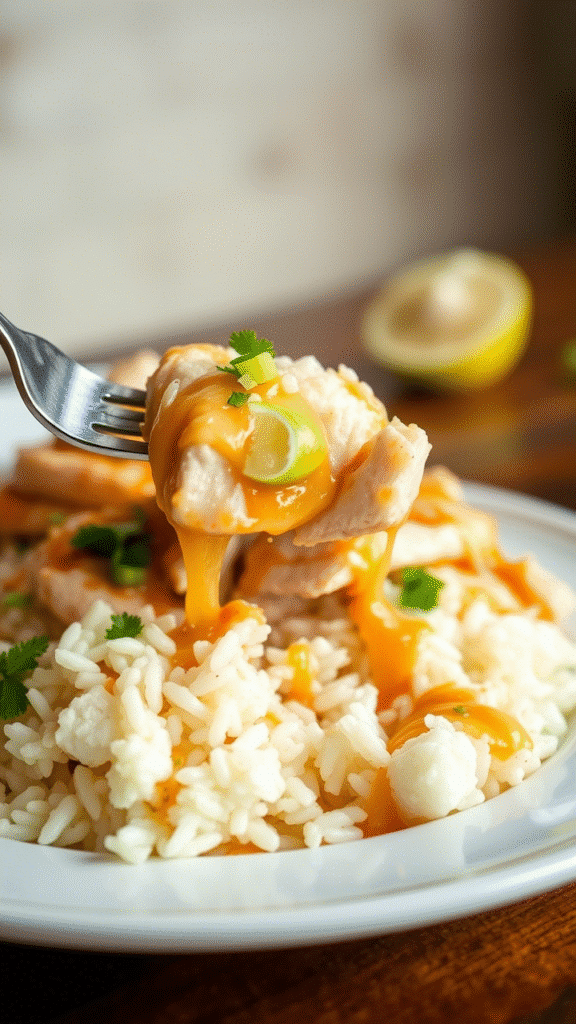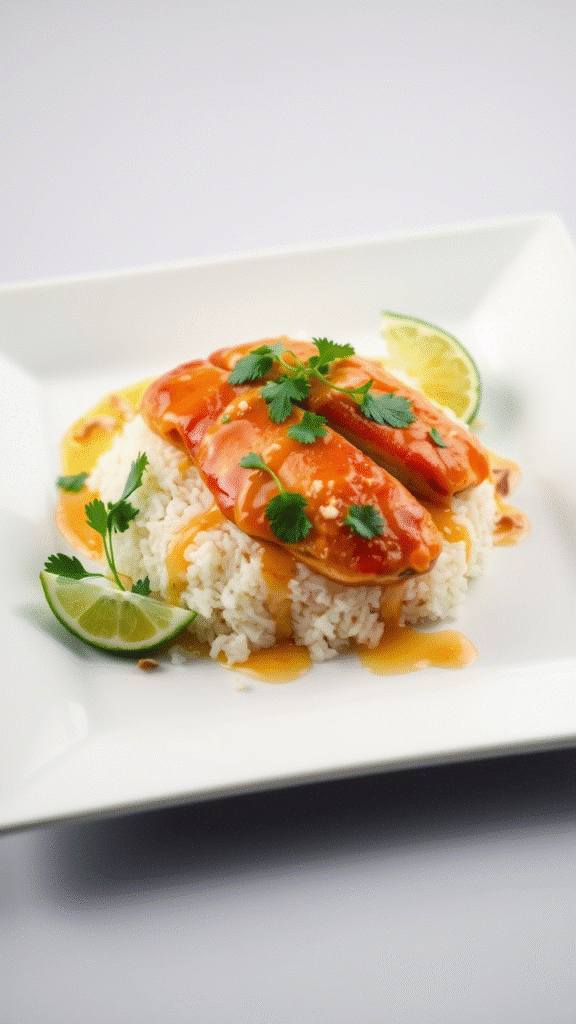I’ll never forget the first time I tasted authentic coconut lime chicken in a tiny beachside restaurant in Koh Samui. The chef, a weathered Thai grandmother with calloused hands, served me a plate that would forever change how I understood the marriage of tropical flavors. The chicken glistened with a golden coconut glaze, each grain of jasmine rice infused with lime-scented aromatics that seemed to capture the essence of Southeast Asian cooking in a single bite.
That transformative meal sparked a decade-long obsession with perfecting this deceptively simple dish. What appears to be just chicken and rice actually represents one of the most sophisticated flavor combinations in tropical cuisine—a delicate balance of rich coconut cream, bright citrus acidity, and aromatic spices that requires genuine technique to master properly.
What Makes Coconut Lime Chicken Special
Coconut lime chicken transcends typical weeknight dinners through it’s complex interplay of fat, acid, and umami. The coconut provides luxurious richness while lime cuts through that richness with surgical precision. This isn’t just fusion cooking—it’s a time-tested combination rooted in centuries of Southeast Asian culinary wisdom.
The magic happens when coconut milk’s natural sugars caramelize against high heat, creating those coveted golden-brown edges that professional kitchens chase relentlessly. Meanwhile, lime zest releases volatile oils that perfume the entire dish, while lime juice tenderizes protein fibers and brightens every component.
Most home cooks struggle with this recipe because they treat it like a simple stir-fry. In reality, coconut lime chicken demands respect for temperature control, timing, and the delicate science of emulsification that separates restaurant-quality results from soggy disappointments.
Ingredients & Substitutions

Protein Foundation
- 2 lbs boneless, skinless chicken thighs (preferred over breasts)
- 1 tsp kosher salt
- ½ tsp freshly cracked black pepper
- 2 tbsp cornstarch (for velveting technique)
Chicken thighs reign supreme here due to their higher fat content and forgiving nature under high heat. Breasts work but require more careful temperature monitoring to prevent dryness. The cornstarch creates a protective coating that keeps proteins tender while enabling proper browning—a technique borrowed from Chinese velveting methods.
For those avoiding poultry, firm fish like mahi-mahi or snapper work beautifully, though cooking times drop significantly. Tofu can substitute but needs pressing and freezing beforehand to achieve proper texture.
Coconut Components
- 1 can (14 oz) full-fat coconut milk, refrigerated overnight
- 2 tbsp coconut oil (refined for high-heat cooking)
- 1 tbsp palm sugar or brown sugar
- 1 tsp fish sauce (or soy sauce for vegetarian version)
Refrigerating coconut milk separates the thick cream from thinner liquid—use the cream for initial searing and reserve liquid for deglazing. This separation technique creates deeper flavor layers than using mixed coconut milk straight from the can.
Coconut oil’s high smoke point makes it ideal for the initial sear, while palm sugar provides subtle caramel notes that white sugar simply cannot match. Fish sauce adds essential umami depth, but high-quality soy sauce offers a vegetarian alternative that doesn’t compromise flavor integrity.
Citrus Elements
- 3 large limes (zested and juiced separately)
- 2 tbsp lime juice (reserved for finishing)
- 1 lime, sliced for garnish
Fresh limes are non-negotiable here. Bottled lime juice lacks the bright volatile oils found in fresh zest and juice. Zest goes into the cooking process early, while reserved lime juice finishes the dish to preserve maximum brightness.
Meyer lemons can substitute in a pinch, offering a sweeter, more floral profile that changes the dish’s character completely. Key limes provide more intense flavor but require about twice as many fruits.
Aromatic Base
- 3 cloves garlic, minced
- 1 inch fresh ginger, microplaned
- 2 shallots, finely diced
- 1 Thai bird’s eye chili, minced (optional)
- 2 tbsp fresh cilantro stems, minced
This aromatic trio forms the flavor foundation that distinguishes professional results from amateur attempts. Microplaning ginger releases more oils than chopping, while cilantro stems contribute intense flavor without the leafy texture.
Shallots provide sweeter, more complex onion flavor than regular onions. If unavailable, use the white portions of scallions plus one small yellow onion. Thai chilies bring authentic heat, but jalapeños work for milder palates.
Rice Selection
- 1½ cups jasmine rice
- 2¼ cups chicken stock (or vegetable stock)
- 1 tsp salt
- 2 tbsp butter
Jasmine rice’s natural floral aroma complements tropical flavors perfectly. Basmati offers similar results, while short-grain rices like Arborio create completely different textures better suited for risotto-style preparations.
Stock instead of water adds crucial depth, while butter stirred in at the end creates restaurant-quality richness. Coconut milk can replace some stock for even more tropical character.
Step-by-Step Instructions
Preparation Phase
Begin by cutting chicken thighs into uniform 1½-inch pieces—this ensures even cooking and professional presentation. Toss with salt, pepper, and cornstarch until evenly coated. Let this mixture rest at room temperature for 15 minutes, allowing the salt to penetrate while cornstarch forms a protective coating.
Meanwhile, prepare your mise en place religiously. Mince aromatics, separate coconut cream from liquid, zest limes, and measure all ingredients. This dish moves quickly once cooking begins—proper preparation prevents disaster.
Rice Foundation
Start rice first since timing matters crucially here. Heat a heavy-bottomed saucepan over medium heat, add butter, then rice. Toast the grains for 2-3 minutes until they smell nutty and some begin turning golden. This toasting step adds depth that plain steamed rice lacks entirely.
Add hot stock, salt, and bring to a vigorous boil. Reduce heat to lowest setting, cover tightly, and cook exactly 18 minutes. Remove from heat but keep covered—residual steam finishes the cooking process perfectly.
The biggest mistake home cooks make is lifting the lid during cooking. This releases essential steam and creates unevenly cooked grains. Trust the process and resist temptation.
Chicken Searing Technique
Heat a large skillet or wok over high heat until it just begins smoking. Add coconut oil, then immediately add chicken pieces in a single layer. Don’t overcrowd—work in batches if necessary.
Let chicken sear undisturbed for 3-4 minutes until golden brown crust forms. This browning reaction (Maillard reaction) creates hundreds of flavor compounds that separate restaurant cooking from home cooking. Moving the chicken too early prevents proper caramelization.
Flip chicken pieces and sear another 2-3 minutes. Remove to a plate—they won’t be fully cooked yet, but will finish later in the sauce.
Building the Sauce
Reduce heat to medium and add minced aromatics to the same pan. The residual chicken fond (those brown bits) will deglaze naturally as aromatics release moisture. Sauté for 1-2 minutes until fragrant.
Add separated coconut cream and palm sugar, whisking constantly to prevent curdling. The cream will initially look broken but gradually emulsifies into a smooth sauce. Add fish sauce and lime zest, stirring to combine.
Return chicken to the pan along with any accumulated juices. Add the thinner coconut liquid gradually while stirring—this creates a silky sauce that coats each piece properly.
Final Assembly
Simmer gently for 8-10 minutes until chicken reaches internal temperature of 165°F and sauce reduces to coat-the-spoon consistency. The sauce should cling to chicken without being thick or gluey.
Remove from heat and stir in reserved lime juice and half the cilantro. This finishing acid brightens the entire dish and prevents the coconut richness from becoming cloying.
Taste and adjust seasoning—you might need more lime juice, fish sauce, or even a pinch of sugar depending on your lime’s acidity level.
Cooking Techniques & Science

Understanding Coconut Milk Chemistry
Coconut milk contains natural emulsifiers (lecithin) that help create stable sauces when handled properly. However, high heat or acid can cause “breaking”—when fat separates from water. Controlled breaking actually enhances flavor by concentrating coconut solids, but uncontrolled breaking creates greasy disasters.
The key lies in temperature control and gradual incorporation. Start with cream, build heat slowly, then add liquid components gradually while stirring constantly. This technique parallels French butter sauce methods but uses tropical ingredients instead.
The Science of Lime Zest vs. Juice
Lime zest contains volatile oils (primarily limonene) that provide intense aromatic impact but dissipate quickly under heat. Adding zest early allows these oils to infuse throughout cooking, while reserving juice for finishing preserves brightness.
Heat converts citric acid in lime juice to other compounds that taste flat and dull. Professional kitchens always add citrus juice after removing pans from heat—this preserves maximum flavor impact and prevents sauce from becoming overly acidic.
Protein Velveting Technique
The cornstarch coating technique, borrowed from Chinese cooking, creates a barrier that prevents protein fibers from contracting excessively under high heat. This results in more tender chicken that retains moisture throughout the cooking process.
Additionally, cornstarch helps thicken the finished sauce naturally without requiring flour roux or other thickening agents. The starch gelatinizes in the coconut milk, creating body and richness that feels luxurious rather than artificial.
Serving & Pairing Suggestions

Plating Like a Professional
Serve over fluffy jasmine rice in warmed bowls, arranging chicken pieces artfully rather than simply dumping everything together. Spoon sauce over and around the rice, not just on top—this ensures every bite gets proper sauce coverage.
Garnish with fresh cilantro leaves, thin lime wheels, and perhaps a sprinkle of toasted coconut flakes for textural contrast. A few Thai basil leaves add aromatic complexity for special occasions.
Complementary Dishes
This rich, creamy dish pairs beautifully with bright, acidic sides that cut through the coconut richness. Consider cucumber salad with rice vinegar dressing, quick-pickled vegetables, or simple steamed Asian greens like bok choy or gai lan.
For beverages, try crisp white wines like Sauvignon Blanc or Albariño, or go tropical with coconut water cocktails. Beer lovers should reach for wheat beers or light lagers that won’t compete with the delicate flavors.
Leftover Innovation
Leftover coconut lime chicken transforms beautifully into fried rice, lettuce wraps, or even quesadilla fillings. The flavors actually improve overnight as they meld together, making this an excellent make-ahead option for busy weeknights.
Conclusion
Mastering coconut lime chicken requires understanding the interplay between fat, acid, and heat that defines professional cooking. This isn’t just another chicken recipe—it’s a masterclass in balancing complex flavors while respecting traditional techniques that have evolved over centuries.
The key takeaways center on preparation, temperature control, and timing. Proper mise en place, gentle heat management, and strategic use of finishing ingredients separate restaurant-quality results from mediocre home cooking attempts.
Don’t be discouraged if your first attempt isn’t perfect. Like any worthwhile dish, coconut lime chicken rewards practice and attention to detail. Each time you make it, you’ll develop better intuition for the subtle cues that indicate when sauce consistency, seasoning balance, and doneness align perfectly.
For troubleshooting, remember that broken sauces can often be rescued by removing from heat and whisking in cold coconut cream gradually. Overly acidic dishes benefit from a pinch of sugar, while bland results usually need more fish sauce and lime zest rather than more salt.
Experiment with variations once you’ve mastered the basic technique. Try different proteins, add vegetables like bell peppers or snap peas, or incorporate other Southeast Asian aromatics like lemongrass or galangal. The fundamental principles remain the same, but the possibilities are endless.
Frequently Asked Questions?
Q: Can I use light coconut milk instead of full-fat?
A: Light coconut milk lacks the richness and emulsification properties needed for proper sauce development. The reduced fat content prevents the characteristic golden browning and creates thin, watery results. If watching calories, use full-fat coconut milk but serve smaller portions over more rice and vegetables.
Q: Why does my sauce keep breaking or looking curdled?
A: Sauce breaking usually results from excessive heat or adding cold ingredients to hot pans too quickly. Always use medium heat after the initial sear, and add liquid ingredients gradually while stirring constantly. If sauce breaks, remove from heat immediately and whisk in cold coconut cream tablespoon by tablespoon until it re-emulsifies.
Q: Can I make this dish ahead of time?
A: Coconut lime chicken actually improves when made ahead—the flavors meld beautifully overnight. However, cook rice fresh for best texture. Store chicken and sauce separately in the refrigerator for up to 3 days. Reheat gently over low heat, thinning with additional coconut milk if needed. Add fresh lime juice just before serving.
Q: What’s the best way to prevent the chicken from becoming tough?
A: Don’t skip the cornstarch coating—it provides crucial protection against overcooking. Also, avoid moving chicken pieces during the initial sear, as this prevents proper browning and can lead to steaming instead of searing. Use a meat thermometer to ensure you don’t overcook past 165°F internal temperature.
Q: Can I substitute dried spices for fresh aromatics?
A: Fresh garlic, ginger, and herbs are really essential for authentic flavor development. Dried versions lack the volatile oils that create depth and complexity. If you must substitute, use about 1/3 the amount of dried spices and add them earlier in the cooking process to allow time for rehydration and flavor development.

Veronica is a passionate food enthusiast with over three years of experience in exploring and writing about diverse cuisines. Her expertise lies in reviewing restaurants, sharing creative recipes, and discovering the latest food trends. As the voice behind FoodieRecap.com, Anju brings fresh perspectives and culinary insights to her audience.
